
The facade of the Giardini, the iconic central pavilion of the Venice Biennale, opened to the general public in its 60th edition on April 20th, is coated with the colorful and vibrant palette of the Mahku collective (Huni Kuin Artists’ Movement). In its monumentality, the intervention envelops the visitor as they enter the vision of curator Adriano Pedrosa about a marginalized and forgotten art history, which echoes for the first time on the biggest stage of international art.
Under the title Strangers Everywhere, the Biennale focuses on the condition of being a foreigner through the works of artists who have never been exhibited in the show. The title is borrowed from the Franco-British duo Claire Fontaine, whose series of neon lights in different colors carry the expression in over fifty Western and non-Western languages, appropriated by the collective from an Italian anarchist group from the early 2000s.
The perception of the foreigner encompasses the movements of migration – forced or voluntary – of the participating artists, but it doesn’t stop there. In the polysemy of the word and its translations, the exhibition expands its scope to include gender and sexuality dissident artists, self-taught outsider artists, or those with educations linked to the transmission of intergenerational knowledge and skills, as well as indigenous artists, “often made strangers in their own territory”, according to Pedrosa himself.
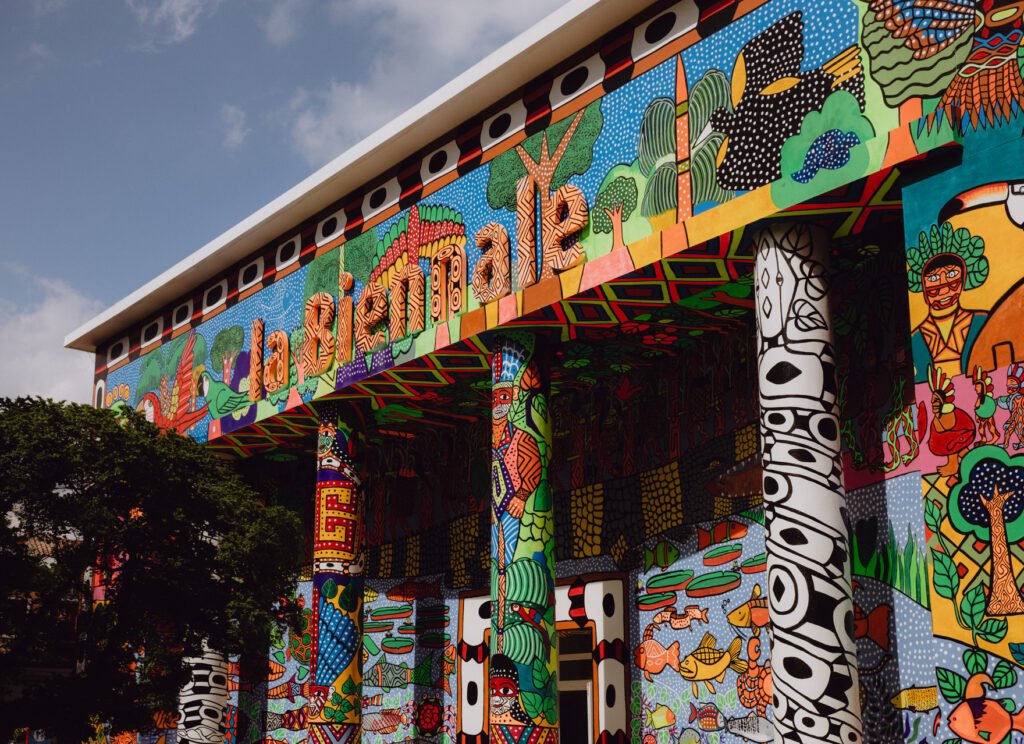
The exhibition brings together 331 participants divided between the contemporary and historical nuclei, a substantial number compared to previous editions, focusing on artists from the global South – a geopolitical designation that encompasses economically and socially marginalized parts of the world, becoming a space of resistance against hegemonic global power structures. The historical section reflects on modernism – or rather, modernisms, in plural form, a hallmark of Pedrosa since his participation in the 24th São Paulo Biennial in 1998, curated by Paulo Herkenhoff. Since then, this practice has become recurrent in the annual thematic revisions of Masp, considering the presence of multiple and overlapping histories.

If the curatorial focus is not new to the curator, it is also not new to the international art scene. Over the past years, institutions such as the Centre Pompidou in Paris and the MoMA in New York have been reconsidering their artistic guidelines to increase the presence of artists from outside the global north. The same can be said for international art exhibitions, such as the 15th Documenta in Kassel, Germany, which was artistically led by the Indonesian group ruangrupa. With the desire to outline collective artistic proposals that allow imagining new economies of production, distribution, and interaction within a collaborative ecosystem, the post-pandemic edition resonated with the condition of migration in various actions before, during, and after the event. This discourse was reflected, for example, in the immateriality of video, the reproducibility of photography, or performance as a way to overcome geographical difficulties. Seeking to reflect on the symptoms of our time, the exhibition design made use of tents that alluded to improvised architectures used to shelter immigrants in precarious conditions.
If such aesthetic and political relationships were preserved in the first two rooms of the main pavilion of the Venice Biennale, resonating Claire Fontaine’s neon with Nil Yalter’s felt tents of nomadic communities in Mongolia, that sentiment dissipates along the way. The prevalence of painting in many rooms highlights the current trend that is sweeping through museums and fairs around the world, impacting not only the understanding of what modernisms were but also what contemporary production is (or could become).
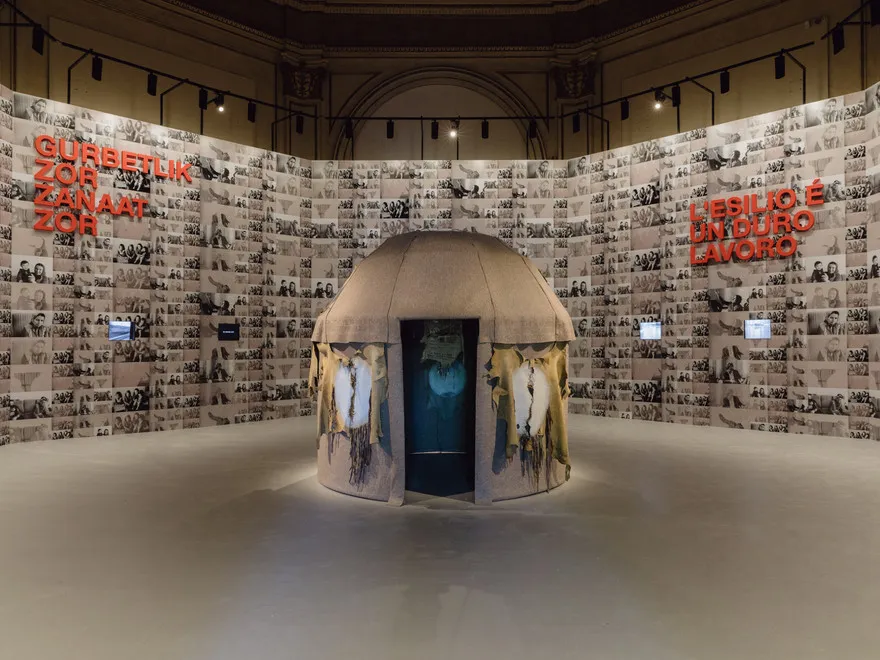
In its first half, the historical nucleus turns to abstractions with a panorama of 37 artists from countries like Brazil, Chile, Morocco, Iraq, Indonesia, South Africa, and others. Beyond painting, the Brazilian artist Ione Saldanha stands out in her vigorous use of color on suspended bamboos, surrounded by names such as Carmen Herrera, Huguette Caland, Fadjar Sidik, and Tomie Ohtake. The discussion takes a different direction in a room of portraits, scattered in a non-linear arrangement, once again with few three-dimensional objects. According to the curator, the selection is “dedicated to portraits and representations of the human figure made in the global South in the 20th century” from 30 countries, in a span ranging from the 1910s to the 1990s. Among more or less geometric figures, different veils and tones, the gazes between the paintings intersect, reaching out to visitors and confusing the notions of who sees and who is seen, or rather, subject and object – thus seeking to question the power dynamics in art.
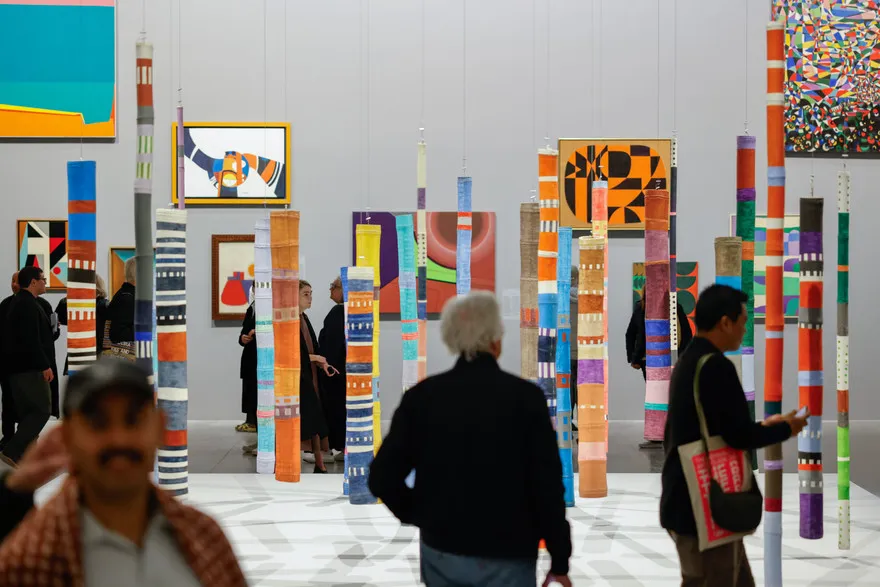
Despite the impact of a room populated by numerous immigrants, the shadow of the classic European gender is heavy, making evident the Western difficulty in imagining even more assertive selections for productions that do not originate in the global North. We must remember, after all, that portraiture in the painting tradition goes hand in hand with the understanding of the individual, which strengthened with the rise of the bourgeoisie in the 15th and 16th centuries in Europe. Addressing such issues in non-Eurocentric contexts involves considering that the very idea of individuality, and thus portraiture, would be less important or even anachronistic before the colonial occupations that spread across Africa, Asia, and South America; there are Brazilian indigenous ethnic groups, as an example, like the Asuriní people from Xingú, where figuration is uncommon, favoring patterns. In this sense, the abstraction room is more successful in moments when it breaks free from a canon, as seen in the textile art of Monika Correa and Olga de Amaral.
It would be frivolous to think cultures showcased in the exhibition had no contact with those from the global North and assimilated them in their own way, as Pedrosa asserts. It is worth considering what reading tools, stemming from the historical rescue of knowledge erased in the past and present, could point to the migrant figure not only as one who adjusts to the demands of the one who makes them the “other,” but also how these cultures could dismantle the foundations of imposed knowledge. As the English critic John Berger wrote in his 1967 text, “No More Portraits”, “we can no longer accept that a man’s identity can be adequately established by preserving and fixing his appearance from a single point of view in one place.”
There are moments of extreme strength in this pavilion: the babbling language works of Romany Eveleigh and Gabrielle Goliath; the provocative paintings of non-classical themes in formally structured tones and shapes by Louis Fratino; the dizzying and mystical 10-meter drawings made with a pen by Madge Gill; Kang Seung Lee’s anti-monuments paying tribute to artists who died due to AIDS-related complications; the encounter of drawings by Joseca Yanomami with the photographs of Claudia Andujar; and the connection between themes such as ecology, means of production, transgender identity, work, religion, and intimacy in the video “Building”, by Manauara Clandestina.
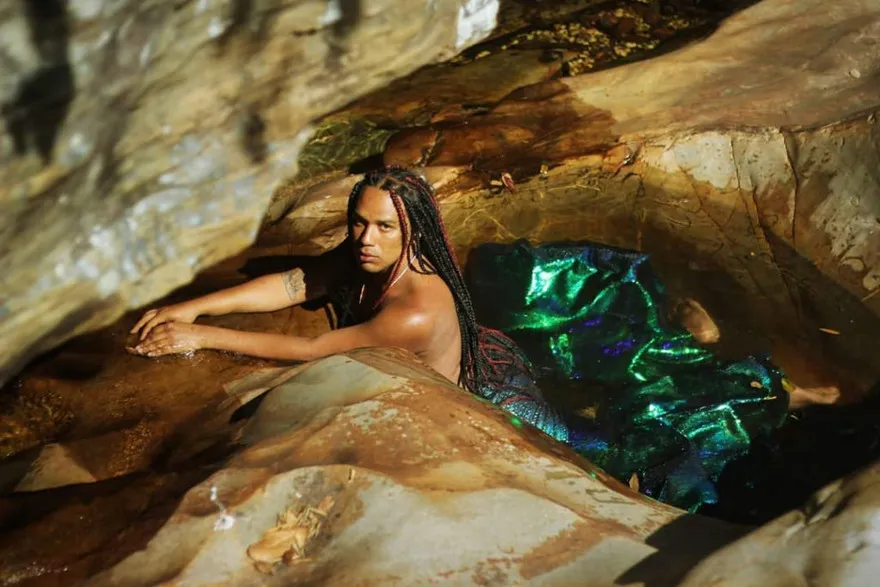
I highlight the indigenous Guatemalan artist Rosa Elena Curruchich, whose small-format canvases signify an act of defiance: belonging to the Kaqchikel Maya ethnic group, her work faced prejudice associated with the male tradition of painting in her community. Self-taught, the artist started creating small paintings in the 1970s, which she would carry hidden to transport them. The size of the canvas contrasts with the detailing of the scenes, which describe, in formidable shapes and text, the female role within her community. The artist went on to become the first female painter of Comalapa (a city in Guatemala).
At the Arsenale, the exhibition welcomes the public with a large installation by the New Zealand collective Maataho, whose woven work embraces the pavilion’s structures and urges the audience to look upwards. However, this doesn’t happen throughout the entire space: there are moments of discomfort, such as in the large installation by Daniel Otero Torres, which leaves little room for the canvases of the Goiás artist Dalton Paula; or in the positioning of the big murals by Frieda Toranzo Jaeger.
The journey strengthens as the body invents its own language or denounces the violences engendered in a system averse to the presence of difference: in the almost surrealistic photographs captured by the Bolivian River Claire; the violence with tones of masochism presented in the large installation by the Mexican Bárbara Sánchez-Kane, where mannequins are dressed in a mix of military clothing with BDSM; the politically charged and sarcastic drawings by the Argentine La Chola Poblete; the photographs of queer desire and intimacy by the South African photographer Sabelo Mlangeni; and the toppling of the Christopher Columbus monument by the Colombian Iván Argote on the exterior of the Giardini, which serves as the ground for the growth of botanical life.
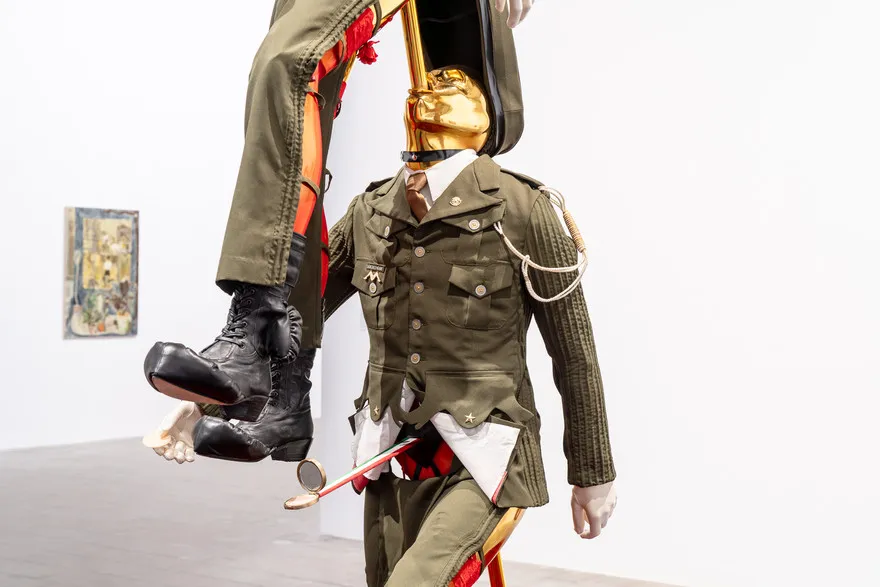
Continuing with his ambitious project, Pedrosa highlights Italian artists who built their careers and studied outside their homeland, presented on the iconic glass easels by Lina Bo Bardi, herself an immigrant to Brazil. While the power of such a gesture might appear timid to those more familiar with Masp, for first-time viewers, the potency of Lina’s exhibition device is unavoidable.
The major highlights of this pavilion are twofold: the first is the video Talitin The Third by Mahmed Umar, which mesmerizes the audience with a dance that intertwines queer stories of Islamic migration. In a traditional Sudanese wedding choreography, Umar uses accessories and garments from his homeland and from New York, Oslo, and Cairo, reenacting the ritual he had learned from the women in his family until the moment he was expelled from home. The second is the large installation Coming and Going by Anna Maria Maiolino, winner of the Golden Lion for the recognition of her work. The artist takes a shelved house in the external space using small handmade clay pieces, aiming to adorn the natural organic cycles of the material. Combined with videos, texts, and soundtracks, the house becomes a living entity that questions the conditions of life and time.


As part of the program, the Disobedience Archive curated by art curator and theorist Marco Scotini, presents a set of 40 videos that are divided between diaspora activism and gender disobedience – the latter in which Brazilian artist Jota Mombaça participates with the video The Birth of Urana. This is one of several works that propose a discussion about queer embodiments and gender dissidence, a foundational aspect of Pedrosa’s Biennale, making him the first openly queer artistic director of an international exhibition.


As for the idea of disobedience, this edition seems to mark the beginning of a movement that lacks bolder actions. Undoubtedly, there are still many who are not represented at the table the curator expands, especially living artists, as even in the contemporary nucleus a significant portion of the names are now in memory. However, this issue seems to be within Pedrosa’s awareness, as he states in an interview with curator Julieta González: “I hope we can learn by looking at the works in their materiality, all under the same roof, in dialogue with each other. Then, perhaps, others can propose new formats, models, genres, and structures.”
The 60th Venice Biennale paves the way to establish the groundwork for a more open and transgressive discussion, aiming at a history that embraces those who have been marginalized not only in its official documentation but also in their survival and presence in a global north increasingly averse to their existence. This symbolic diaspora in this edition, as necessary as it is violent, threatens the loss of other sensitivities and understandings of material culture. In this sense, the sculpture by Maria Martins, positioned at the center of the portraits room, serves as a warning: “Do not forget that I come from the tropics.”